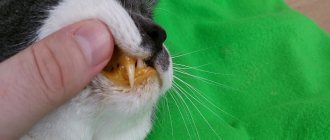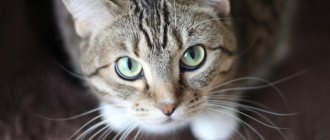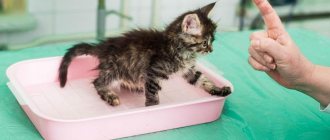A cat's eyesore is a serious condition that can lead to partial or complete loss of vision. Even the owner of a purring cat can visually identify the thorn - the affected eye seems to have become cloudy and changed color. If you suspect something is wrong, you need to take your pet to the vet as soon as possible.
The main causes of eyesore:
- endocrine pathologies of the body (diabetes mellitus);
- mechanical eye injuries;
- poor hygiene when keeping a pet;
- unbalanced diet;
- degenerative processes in the eyeball;
- infectious processes caused by a bacterial, viral or fungal nature.
In addition, there are a number of diseases that affect the eye itself in cats, which ultimately leads to the formation of leukoma. There are a number of main diseases:
- Nuclear sclerosis is a change in the density of the transparent core of the lens with aging, characteristic of older animals. Nuclear sclerosis is caused by excessive compression of old lens fibers in the nucleus and the further development of new ones. The new dense fiber leads to strong dispersion of the light flux.
- Cataracts are a dangerous disease that is diagnosed not only in old cats, but is also observed in young ones. The development of cataracts is mainly provoked by diabetes mellitus and parasitic infestations.
- Glaucoma is a pathological process characterized by pressure inside the eyeball. In this case, the functioning of all functions of the eye is significantly impaired. It increases in size, severe pain occurs, the pet squints its eye, and the cornea becomes cloudy. Edema of the eyelids is also observed, and hemorrhages are observed in the tunica albuginea.
- Conjunctivitis is a pathology that occurs during pathological inflammatory processes in the eye due to a foreign body entering the eye or due to allergic-type reactions. Features of the characteristic inflammation of the conjunctival sac are the accumulation of specific fluid in the area of the outer shell of the eye.
- Uevitis is an inflammation of the vascular part of the eye. This pathology is characterized by the development of severe pain, blepharospasm, and clouding of the fluids in the eyeball. Untimely treatment of uevit leads to the development of adhesions, cataracts, glaucoma and blindness. The main reason for the development of ueviitis in domestic cats has not yet been determined.
- Keratitis is an inflammation of the cornea itself, developing against the background of infectious diseases. More often, keratitis is diagnosed with concomitant systemic intoxications of the body and conjunctivitis.
Symptoms of a cat's thorn
If, after looking into the animal's eyes, you notice cloudiness, it means that the cataract is already there. Additional signs of the disease include the following list:
- Deterioration of vision - the cat is poorly oriented in space, peers into the distance for a long time, recognizes its owners by smell, and bumps into furniture and corners of rooms.
- Nervousness, irritability, excitability due to loss of ability to navigate in space.
- Another option is strabismus.
- If the eye hurts, the animal hisses when the owner tries to wash it.
- Discharge.
- Redness of the mucous membrane and swelling of the cornea.
Symptoms and diagnosis of the disease
When a cataract forms, the cat experiences a number of characteristic symptoms, but the main one is the increased secretion of lacrimal secretion from the excretory canal.
An eyesore is often diagnosed after mechanical injuries complicated by pathogenic bacterial microflora. In the corners of the pet's eyes there is an accumulation of a specific exudate of a purulent nature. The shade of the cornea changes, and the structure becomes rough. Characteristic symptoms of leukoma formation in cats are:
- severe clouding of the cornea (a specific spot is formed that disappears over several days);
- secretion from the affected area;
- significant decrease in vision in a cat;
- the animal tries to avoid bright sunlight, hiding in dark corners;
- the cornea changes its color, acquiring a characteristic yellowness.
If you find a spot on your pet's eye, it is not recommended to self-medicate. It is important to contact a qualified specialist to prescribe treatment. First of all, when visiting a doctor, a general clinical examination is carried out and the appropriate laboratory and instrumental tests are prescribed:
- blood test for serology (detection of herpesvirus infection, often leading to the development of conjunctivitis);
- puncture of the eyeball (paracentesis) is a necessary test if serious eye diseases are suspected;
- examination of tear secretion is carried out to diagnose the presence of bacterial or pathogenic fungal microflora.
If necessary, electroretinography is performed, which makes it possible to assess the position of a specific layer (retina) and diagnose detachment. Serious damage to the eyeball requires the use of ultrasound
What should the owner do?
Check your cat's eyes at least twice a day. If you see signs of a worsening process, that is, increasing redness, loss of vision, pain reactions or an increase in the volume of exudate, call the veterinarian immediately. If even before the start of treatment the cat’s vision has become noticeably worse, allocate it a minimally furnished room. This is done so that she does not accidentally get injured by running into a table leg, for example.
Don't let your cat rub his eyes. To do this, ask your treating veterinarian for a surgical collar for the animal, since there is simply no other reliable way. Never self-prescribe medications, especially those intended for humans. Believe me, taking some Visine for glaucoma is pointless.
We suggest you read: Pug's eyes are festering
On the contrary, give your pet all the medications prescribed by the veterinarian exactly on time and in full doses, and regularly take your cat to him for appointments.
Therapy
Treating a cat's eyesore requires a comprehensive approach. Of great importance in determining the course of therapy is the diagnosis (statement of the underlying disease that caused leukoma). The stage of the disease and the previous clinical picture matter.
Timely diagnosis and first aid for the cat determine further tactics. In the vast majority of cases, this is conservative therapy with the use of medications.
Severe cases, accompanied by serious symptoms and complications, require surgical intervention. During the operation, the surgeon carefully removes the resulting film, replacing the affected area of the cornea with artificial tissue.
Varieties of the disease
There are congenital and acquired thorns. Belmo most often occurs in older cats, but young cats are also susceptible to its appearance. Leukoma can cover the entire eye, then based on its location it is characterized as a total type of disease. If the pupil is clouded, completely or partially, this is a central view. When any part of the eye is clouded, but if the pupil is clear, it is a peripheral appearance.
Of course, the main symptom of the development of leukoma is cloudiness of the eye. But besides this there are others. For example, the owner may suspect a thorn if the pet has become poorly oriented in a previously well-known space and begins to bump into household objects, people and other animals. In addition, symptoms such as:
- nervousness of a cat that has lost the ability to move and navigate freely;
- hissing when washing with paws or if the owner tries to touch the eye area;
- sometimes squint is possible;
- redness of the eyes;
- the cornea is swollen, swelling and profuse discharge from the eye are noticeable.
With a central or peripheral form of the disease, cats' visual acuity may simply deteriorate, but it will persist. Therefore, it is worth monitoring your pet’s behavior more closely to prevent further development of the disease.
In addition to a visual examination, the presence of the disease can be checked by performing a complete and biochemical blood test, and measuring the pressure inside the eye. Doctors also resort to serological testing, ophthalmoscopy, gonioscopy with a slit lamp and other methods.
The first sign that indicates the occurrence of a cataract is cloudiness of the organ of vision. However, there are other symptoms that help to suspect the presence of leukoma. Often, in the initial stages of development, cats begin to have difficulty navigating in a room that was previously very familiar to them. Animals bump into objects, owners. The following symptoms are also identified:
- nervousness and anxiety;
- hissing when washing or touching the owner's visual organs;
- development of strabismus;
- redness of the mucous membrane of the visual organs;
- swelling of the cornea and increased production of tears.
For minor injuries that do not pose a particular danger to the animal’s vision, the following symptoms may be observed:
- The cat suddenly becomes cross-eyed and tears are constantly flowing.
- The animal's eyes turn red and may become noticeably swollen.
- If you look at the cornea, you can often see a slight cloudiness, that is, cloudiness of the eye.
- Discharge of a small amount of blood.
- Swelling and protrusion of the third eyelid.
- The animal constantly rubs its eyes with its paws.
The animal meows hoarsely in pain, not allowing him to even touch his sore eye.
Visually visible foreign body.
The eyelids are always closed, the cat tries not to open its eyes even in the dark.
Tears, mucous or purulent exudate (which may already indicate the presence of a foreign body), or even blood, are constantly running from the eyes.
The cat bumps into objects and people, and shows other signs of sudden blindness.
Sudden and very significant changes in the color of the iris, severe clouding of the cornea, blood vessels clearly visible on the cornea, etc.
Any changes in the shape of the eyeball and its structure, signs of deformation of the areas around the eye socket (which often happens when an animal is hit by a car or bicycle).
Lethargy, reluctance to eat or drink.
Presence of signs of injury to other parts of the body (which also hints at a “meeting” with a car/bicycle or a fall from a height).
Treatment of an eyesore in a pet with medications includes:
- thorough cleansing of the affected areas of the cornea with special disinfectants;
- use of antibacterial ointment in the lower eyelid area;
- administration of painkillers in the form of drops;
- instillation of drops, widely used in the field of ophthalmology to eliminate symptoms;
- washing the affected eye with antiseptic agents that relieve inflammation and discomfort.
Leukoma can be cured only through complex treatment using evidence-based medicine and traditional methods. It is important to note that infusions and decoctions of medicinal plants to clean the affected eye of a cat can only be used after consultation with the treating veterinarian and in combination with medications. You can use resin from fir trees, celandine mixed with propolis, a decoction of chamomile and calendula.
Measures to prevent eye diseases in cats
The main remedy needed for prevention is a special solution that must be used to wash the eyes of cats. In addition to the solution, in some situations you can recommend a chamomile solution. Don’t forget about a cotton pad, which must first be thoroughly moistened with water. It is with the help of this device that you can wash your animal's eyes.
After completing the procedure, do not forget to wipe your eyes with a cotton swab. Don’t forget that before starting this process, you need to wash your hands thoroughly (with soap) to avoid introducing any infection into your pet’s eyes. It can also be recommended to consider the animal’s diet as a preventative measure, because proper nutrition of your pet is a fairly important factor in preventing the occurrence of any health problems.
Remember that the sooner you discover any health problems with your animal, the sooner you can help him. You should not self-medicate, it is better to immediately try to contact professional veterinarians and send your animal to them for treatment, otherwise any unpleasant consequences are possible, because the animal body is a rather complex system that needs the help of someone who knows what to do, and this is vet. Don’t forget about this, and then everything can end in your cat’s healing and recovery. Good luck!
Prevention is always better than cure. Keratitis in cats is no exception.
- Don't forget about vaccination. Timely vaccinations help create strong immunity, which will protect the animal from infection. This means that the risk that the cat will develop keratitis is much less.
- Examine your cat's eyes after being outside. If you notice watery eyes, again carefully examine your eyes to rule out exposure to mechanical irritants.
- The house must be clean. Wipe off dust thoroughly and wash floors.
- Brush your pet. Lost hair can also get into the eye and rub the conjunctiva and cornea, causing inflammation.
- Watch your diet, don’t forget about fortification and deworming. Strengthen the immunity of your beloved four-legged friend.
- As always, no self-medication. An erroneous self-diagnosis and treatment chosen “on your own” or based on advice from the Internet can only harm the pet. The cat will lose his sight once and for all.
Cloudy eyes in cats are a common problem that causes serious concern for pet owners. Clouding of the cornea in cats may indicate the development of an ophthalmological disease, which can affect both one or both organs of vision.
In some cases, clouding of the eyes in cats is temporary and does not pose any danger to the pet. But in the presence of serious pathologies, it can lead to complete or partial loss of vision for the animal. A veterinarian will help determine the specific cause of the problem, so under no circumstances should you delay a visit to the doctor.
We suggest you read: How to potty train a cat, effective methods
Symptoms of cloudy eyes in a cat can appear both in the initial and more severe, advanced stages of the disease.
It is very important to determine the presence of pathology in the early stages, since the effectiveness of treatment and the preservation of full vision in the cat depend on this.
Signs of the disease can appear in both kittens and adult pets. Most often they look like this:
- A whitish veil or so-called cataract appears on the mucous membrane of the cornea of the eye.
- Swelling and redness of the ocular conjunctiva.
- Development of photophobia.
- Increase in the size of the organ of vision.
- The eye may protrude beyond its limits.
- Dilation of blood vessels inside the organ of vision.
- The appearance of purulent or mucous discharge from the eye.
A cloudy eye in a cat is accompanied by changes in the animal's behavior. It becomes irritable and restless, it loses its appetite, and the pet can lose a lot of weight. You should not wait for the disease to progress to an advanced form - at the first signs of cloudy eyes in a cat, you should immediately visit a veterinarian.
Preventive measures
It is not always possible to completely get rid of a cat's eyesore. It all depends on the degree of the disease and the factors that provoked the disease. It is within the power of a cat owner to avoid the development of a dangerous pathology. To do this, it is necessary to regularly examine the eyes for the presence of ulcerations, injuries or minor damage.
It is possible to avoid the development of eyesores caused by infectious diseases if you carry out timely immunization of the cat according to the vaccination calendar. Prevention involves timely treatment of bacterial and fungal infections in cats on the skin or in the head and ears.
The cat's diet should be balanced, rich in vitamin and mineral complexes. Don’t forget about regular preventative examinations with your veterinarian.
Causes
Veterinarians divide the causes of eyesores into two main groups: congenital and those that appear during life.
Congenital lesions account for only 7-10% of cases. This can happen if the organ of vision is not formed correctly or due to the fact that the cat was very sick during pregnancy. In this case, most often the problem affects several or even all kittens in the litter.
The following factors can lead to an acquired thorn:
- infections and viruses that affect the cat’s body;
- parasitic diseases localized to the cornea;
- mechanical damage and injury to the eye or nearby areas;
- metabolic disorders leading to excessive accumulation of cholesterol and calcium;
- prolonged action of the allergen;
- impaired renal function, leading to severe swelling of the mucous tissues and conjunctiva;
- destructive processes caused by aging.
About 90% of cases are of the acquired form, which is most often reversible. Even after serious injuries, when it seems to the owners that their vision cannot be saved due to a huge spot on the cornea, veterinary care in most cases can fully or partially restore the animal’s ability to see the world around normally.
Description of the disease
The term “cataract” (or leukoma) refers to a clouding or scar on the cornea of the eye resulting from an inflammatory disease, allergy, burn or injury. The cornea is restored after damage, and connective tissue grows in this place. captivating the eye with a white film.
Depending on the shape and location of the spots, they are divided into:
- Peripheral. Located along the edge of the eyeball. If the process is stopped in time, the dog’s quality of life is preserved, since only peripheral vision is lost.
- Central. The film covers the very center of the eye, and it completely stops functioning. The animal can only distinguish between light rays, but does not see pictures or images.
- Total. The film covers the entire eye, resulting in complete blindness of the dog.
In the practice of veterinarians there are also bilateral cataracts. The spots themselves have a milky white or yellowish-white tint. Under the influence of inflammatory processes in the cornea, the thorn may swell and begin to rise above the cornea of the eye. In some stages, the leukoma begins to fuse with the iris of the eye.
Symptoms
Belmo is a dense white film that may have a gray or yellow tint. If the cause of the disease is an ulcerative lesion, then the surface of the cornea will be bumpy and unevenly colored.
With increased intraocular pressure, the cataract bulges outward; this formation is called staphyloma.
If an injury or damage passes through the pupil, then scarring changes its shape due to fusion with the iris.
Leukoma is often complicated by degeneration into adipose tissue; such a change leads to complete atrophy of the eye and usually develops in the presence of a fistula in the cornea.
It is very important to notice the beginning signs of corneal leukoma in your pet as early as possible. This should be done at the stage of inflammatory diseases and injuries, since the thorn itself is in fact scar tissue and its treatment is extremely difficult.
The main symptoms of eye disease with leukoma:
- Photophobia, lacrimation.
- The appearance of purulent discharge.
- With vascular keratitis, surface turbidity with a gray-red tint is observed.
- Purulent keratitis has a light yellow opacity.
- Nodules may form.
The thorn affects visual acuity in cats. The smaller it is in area and the further away it is from the pupil, the less vision decreases. If the pupil is not completely blocked, then clarity of vision is maintained, but its quality decreases.
Measures to prevent diseases that lead to cloudy eyes
The condition of the eyes of a sick cat must be constantly monitored - at least twice a day. If you observe sudden redness (which indicates an inflammatory reaction), the appearance (or increase in volume) of discharge, a painful reaction or deterioration in the cat’s vision, immediately call a veterinarian, since all the signs we described indicate a sharp worsening of the pathological process.
To prevent this from happening, try to minimize all stress factors that can negatively affect your cat's vision. In addition, if the animal’s vision has already been damaged, keep it in a room where chairs and other interior items that a sick pet could stumble upon and get hit hard have been removed.
We invite you to read: Detailed description and characteristics of the Bengal tiger
It is imperative to prevent episodes of self-injury to the eyes. A surgical collar, also called an Elizabethan collar, is ideal for this purpose. It completely encircles the pet’s neck, and also, thanks to its dimensions, prevents the cat from rubbing its eyes with its paws, introducing even more pathogenic and conditionally pathogenic microflora there.
On the contrary, if your veterinarian prescribed any medications for your sick pet, use them strictly on schedule, without skipping doses. Under no circumstances replace them with analogues without first consulting with your veterinarian.
If you notice that after taking a drug your pet begins to behave inappropriately, tears flow from his eyes or something similar, stop prescribing the drug and immediately notify the treating specialist about the observed signs.
This is what the fact that a cat has one eye is cloudy can indicate. It is very possible that this is a sign of some dangerous disease that can only be defeated in a well-equipped veterinary clinic.











